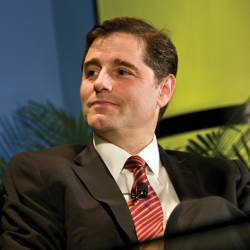
Newly available frequencies in the broadcast spectrum should increase Internet access and spur innovation, U.S. Federal Communications Commission (FCC) Chairman Julius Genachowski said in opening those frequencies to unlicensed commercial use.
When TV broadcasters switched to narrower digital channels in 2009, they freed up frequencies below 700 megahertz, the so-called “white spaces” between channels. Signals at these frequencies can travel about three times as far as the traditional Wi-Fi frequency of 2.4 gigahertz, and easily penetrate buildings and other physical obstacles.
The new FCC rules create room for two classes of devices: fixed, high-power ones that transmit at up to 4 watts and portable, low-power devices limited to 100 milliwatts. Harold Feld, legal director of Public Knowledge, a Washington, D.C., public interest group, says thousands of small wireless Internet service providers in rural areas, underserved by broadband connections, will be quick to take advantage of the range and penetration, to achieve good coverage with fewer towers.
But that will not happen tomorrow. “It’s going to take a minimum of 18 months to get even the most basic devices approved and out there,” Feld says.
Neeraj Srivastava, vice president of marketing at Spectrum Bridge, a wireless networking company in Lake Mary, FL, that works with white spaces, expects the first enhanced Wi-Fi systems, using fixed devices, could start appearing in the first quarter of 2011. Under experimental licenses from the FCC, Srivastava says Spectrum Bridge has run several pilot programs that demonstrate the near-term uses.
One project provided the connectivity to deploy smart grid power monitors across the electrical system in Plymouth, CA. By placing white-space radios at substations, Spectrum Bridge created a wireless network to keep track of power usage and simultaneously supplied the town’s residents with wireless broadband. A project in Wilmington, NC, provided wireless links to inaccessible water-quality monitors and traffic-monitoring bridge cameras. At a hospital in Logan, OH, where concrete walls blocked Wi-Fi and the building’s structure made cabling difficult, Spectrum Bridge created a wireless network to monitor patients, share data, and access security cameras. They also brought broadband access to rural Claudville, VA.
The 4-watt applications can use existing standards; Spectrum Bridge used a modified WiMAX radio in the Logan hospital, for example. Meanwhile, IEEE is working on a standard for the low-power devices, comparable to its 802.11 standard for Wi-Fi. That will determine the design of chips for the smartphones and laptops that will use them, Srivastava says, so it may be more than two years before the appearance of the first low-power applications.
Feld believes that, as the utility of white spaces becomes apparent, the FCC will look for more spectrum to release. “As people think about how you could have radios that are more cognitive, more sensitive to their spectrum environments and act accordingly, people are going to want to see that technology become more widely available,” he says.
Srivastava notes that when the FCC made the spectrum now used by Wi-Fi available in 1985, the popular wireless applications were garage door openers and baby monitors. Nobody had thought of Bluetooth, Wi-Fi, or home networking. “There’s always a third class of devices, and those are the unknown ones. Those probably have the most promise, but I can’t tell you what they are,” Srivastava says.




Join the Discussion (0)
Become a Member or Sign In to Post a Comment